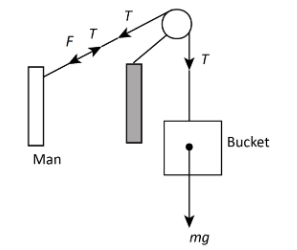
A man drawing a bucket of water falls back when the rope snaps. This is because of
A. Law of gravitation
B. 1st law of motion
C. Newton’s II law of motion
D. Newton’s III law of motion
Answer
558.6k+ views
Hint: Newton’s first law concerns the body at rest or moving with uniform velocity, Newton’s second law of motion concerns with the force and acceleration and Newton’s third law of motion concerns with action and reaction forces.
Complete answer:
From the question, we have a scenario when a man is pulling a bucket of water. Let us assume that the man is pulling a bucket in a vertical direction. A man is pulling a bucket from a well as shown in the figure below.

Let us assume that the pulling force applied by the man is $F$ and we know that it will be equal to the tension ($T$) in the rope and it balances the weight ($mg$) of the bucket. When the force is applied by the weight of the bucket, he will be able to pull the bucket. But when the rope snaps, the pulling force applied by the man will not transmit through the rope and the man falls backwards. So, the pulling fall is the action and when the rope snaps and falls backwards is the action.Thus, a man drawing a bucket of water falls back when the rope snaps. This is because of Newton’s third law of motion.
Hence, option D is the correct answer.
Note:According to Newton's third law of motion, for every force (action), there is equal force (reaction), but in the opposite direction. Example: walking on the floor. This law signifies a particular symmetry in nature: forces always occur in pairs, and one body cannot exert a force on another without experiencing a force itself.
Complete answer:
From the question, we have a scenario when a man is pulling a bucket of water. Let us assume that the man is pulling a bucket in a vertical direction. A man is pulling a bucket from a well as shown in the figure below.

Let us assume that the pulling force applied by the man is $F$ and we know that it will be equal to the tension ($T$) in the rope and it balances the weight ($mg$) of the bucket. When the force is applied by the weight of the bucket, he will be able to pull the bucket. But when the rope snaps, the pulling force applied by the man will not transmit through the rope and the man falls backwards. So, the pulling fall is the action and when the rope snaps and falls backwards is the action.Thus, a man drawing a bucket of water falls back when the rope snaps. This is because of Newton’s third law of motion.
Hence, option D is the correct answer.
Note:According to Newton's third law of motion, for every force (action), there is equal force (reaction), but in the opposite direction. Example: walking on the floor. This law signifies a particular symmetry in nature: forces always occur in pairs, and one body cannot exert a force on another without experiencing a force itself.
Recently Updated Pages
Master Class 11 Economics: Engaging Questions & Answers for Success

Master Class 11 English: Engaging Questions & Answers for Success

Master Class 11 Social Science: Engaging Questions & Answers for Success

Master Class 11 Biology: Engaging Questions & Answers for Success

Class 11 Question and Answer - Your Ultimate Solutions Guide

Master Class 11 Business Studies: Engaging Questions & Answers for Success

Trending doubts
10 examples of friction in our daily life

One Metric ton is equal to kg A 10000 B 1000 C 100 class 11 physics CBSE

Difference Between Prokaryotic Cells and Eukaryotic Cells

1 Quintal is equal to a 110 kg b 10 kg c 100kg d 1000 class 11 physics CBSE

Explain zero factorial class 11 maths CBSE

What is a periderm How does periderm formation take class 11 biology CBSE




